Agricultural Experiment Station
Oct 2023 - Sept 2024 Research Impact
Scientists at UC Davis who are supported by Agricultural Experiment Station funding do research and outreach that address challenges in food and agriculture, natural resources, community development and many other areas that benefit society.

Research at the UC Davis College of Agricultural and Environmental Sciences is spread across three main areas of emphasis.

Agricultural Sciences
- Animal science
- Biological and Agricultural Engineering
- Entomology and nematology
- Plant pathology
- Plant sciences
- Viticulture and enology
Environmental Sciences
- Environmental science and policy
- Environmental toxicology
- Land, air and water resources
- Wildlife, fish and conservation biology
- Agricultural and resource economics
- Food science and technology
- Human ecology
- Nutrition
Choose a topic to view our research in a specific area
Research Projects
$-.- Million - Expenditures
Research conducted with Agricultural Experiment Station funding at the UC Davis College of Agricultural and Environmental Sciences touches the people of California and the world beyond. Projects range widely from topics such as ‘applied freshwater predator-prey ecology’ to ‘designing healthy youth environments.’ Hover over the circles to view details about project titles, funding and associated departments.
Agriculture

Funding Information
Total Funding: $- Million
# of Projects: -
Departments
Legend
Each circle represents a research project in a given topic.
-
Agriculture
-
Environment
-
Human and Social
Size of each circle correlates to the funding that a project receives.
Geographical Impact
$-.- Million - Helping California
Researchers in the College of Agricultural and Environmental Sciences impact California in numerous ways and discover new knowledge in the areas of: sustainable agriculture, environmental conservation, nutritious food, clean water and human health.
This map represents a small fraction of the 300+ faculty who provide critical scientific solutions to some of our state and nation’s biggest challenges. Hover over icons to explore the research we are doing in California.
Agriculture

Funding Information
Total Funding: $- Million
# of Projects: -
Departments
Contributors
$-.- Million - Funding Sources
Transparency is important to us at the College of Agricultural and Environmental Sciences. Below you'll find a list of the funding sources that provide us with the tools to continue researching topics of importance to California and beyond.
Spotlights
$-.- Million - The Impact
Research in the UC Davis College of Agricultural and Environmental Sciences has an impact on California and beyond. Check out these highlighted articles for a more in-depth look at what we are doing in the fields of agriculture, the environment and the human and social sciences.
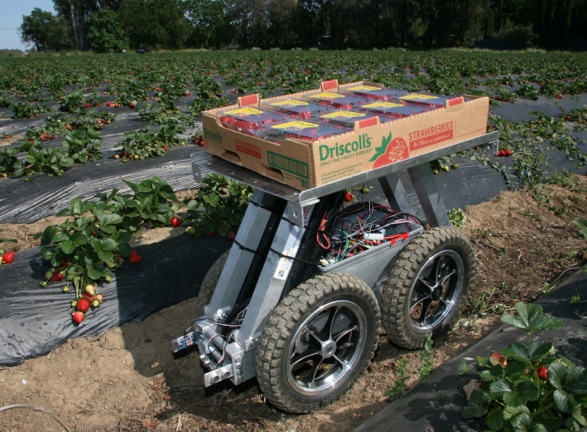
A prototype helper robot transporting fresh-picked strawberries.
Agriculture

Mechanical Crop Harvesting
Department: Biological and Agricultural Engineering
Importance
Harvesting crops and fresh market fruit is among the most labor-intensive elements of any agricultural operation in terms of cost and dependence on a seasonal and sometimes semi-skilled workforce.
Impact
Agricultural robotics can automate and simplify many processes, speeding up harvesting, reducing labor needs and increasing efficiency. Researchers used camera-based sensing, conventional picking bags and an algorithm to maximize performance and were successful in creating a functional robotic orchard platform that achieved up to 25 percent faster harvesting speeds compared to the standard non-automated platform.

UC Davis “Valiant” strawberry among new varieties developed by the Strawberry Breeding Program.
Agriculture

Strawberry Breeding Program
Department: Plant Sciences
Importance
Plant breeders are using genetics to create new varieties of germplasm that satisfy the needs of consumers, who want the fruit to be bright red, sweet and juicy; and growers, who want plants to be high-yielding and resistant to diseases. For more than 70 years, our researchers have revolutionized the strawberry industry by developing prominent strawberry varieties that support a market that leads to nearly $3 billion in sales annually.
Impact
Strawberries are vulnerable to soil-borne pathogens, which can destroy plants and greatly reduce yield. The goal of the Strawberry Breeding Program is to develop new varieties of strawberry plants that have higher quality berries, are less vulnerable to pests and diseases and can be grown more efficiently. CA&ES researchers have released seven new varieties in the past two years.

Student looks through the many choices of soft drink available at the Memorial Union.
Beverage Consumption Attitudes
Department: Human Ecology
Importance
Reducing the amount of sugar-sweetened beverages consumption has become a major public health priority. Sugary drinks have been shown to contribute to weight gain and obesity, tooth decay, type 2 diabetes and cardiovascular disease.
Impact
Researchers found that simple, bright yellow warning labels on beverages like fruit-flavored drinks, sweetened teas and flavored milk in a college cafeteria helped students reduce their reported consumption of drinks by 14.5 percent. The results signal that such labels could reduce sugar consumption in larger settings.

Cattle feed containing seaweed was given to dairy cows at UC Davis.
Environment

Reducing Cattle Methane Emissions
Department: Animal Science
Importance
As cattle digest their food throughout the day, they burp and exhale methane, a potent heat-trapping gas.
Impact
Adding a touch of seaweed to cattle feed can dramatically cut greenhouse gas emissions from dairy cows and livestock by up to 80 percent. This discovery can help California’s farmers meet new carbon emission standards to reduce methane by 40 percent by 2030, receive carbon credits using emission reduction protocols, and produce food sustainably to help feed the world.
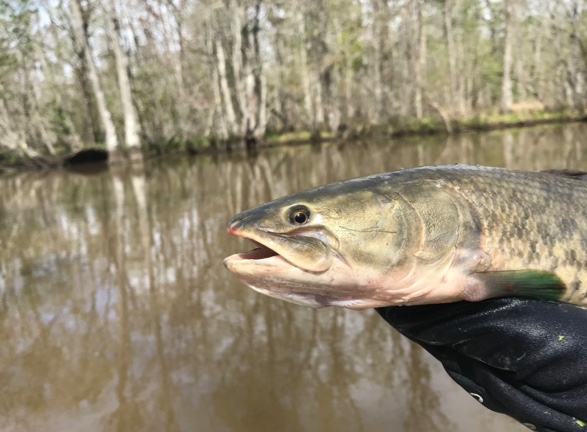
Bowfin fish are native to North America; photo credit: Solomon David, Nicholls State University.
Environment

Cultural Biases Impact Native Fish
Department: Wildlife, Fish and Conservation Biology
Importance
Colonialist attitudes toward native fishes are rooted in elements of racism and sexism, and those attitudes continue to shape fisheries management today, often to the detriment of native fishes. Nearly all states have policies that encourage overfishing native species. Up to half of fish species globally are in some form of decline and 83 percent of native California fish species are declining.
Impact
Native fishes help ecosystems in many ways, including nutrient cycling and food chain support for other native species. Researchers offer several recommendations for how anglers and fisheries managers can shift to a new paradigm for integrating changes, including indigenous perspectives, bag limits, and supporting science on native fish.

Students are introduced to vertical farming and learn how sustainable it can be.
Agriculture

Controlled Environment Agriculture
Department: Plant Sciences
Importance
Traditional agricultural methods could be disrupted by drought, flood and extreme weather as climate change intensifies. Growing crops in a closed-loop system where lighting, water and ventilation are controlled provides a way to maintain food sources while also avoiding climate instability and reducing risk of foodborne pathogens.
Impact
Inside a 40-foot long shipping container, students are learning how to be next-generation farmers with skills in engineering, computer science and growing crops such as lettuce and other leafy greens. This laboratory helps us to better understand hydroponic growing systems to provide nutrition to a growing population.
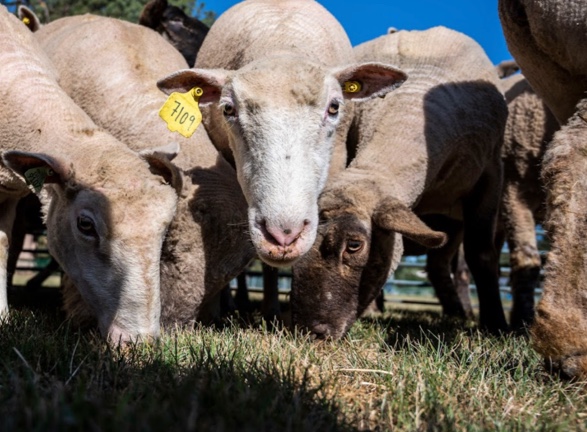
Sheep graze on UC Davis campus.
Managing Landscapes with Sheep Mowers
Department: Human Ecology
Importance
This ongoing research project aims to determine if sheep, which intermittently graze a lawn on campus near the UC Davis Arboretum, can eat weeds and grass, fertilize the land and control pests as well as or better than using conventional landscaping methods.
Impact
Incorporating sheep into an existing urban green space has the potential to offer multiple operational, environmental and social benefits.
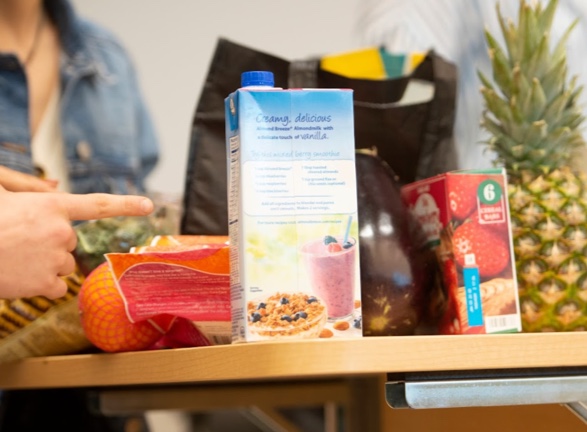
Students participating in a diet comparison project in the Nutrition department.
Identifying Food Biomarkers
Department: Nutrition, Food Science and Technology
Importance
The foods we eat can directly affect overall health and disease risk. But it’s not one size fits all and new methods are needed to track how an individual responds to food.
Impact
The Dietary Biomarkers Development Center is using clinical trials to identify specific food biomarkers, which are indicators of what someone has eaten. The findings could lead to support personalized nutrition and culinary medicine.
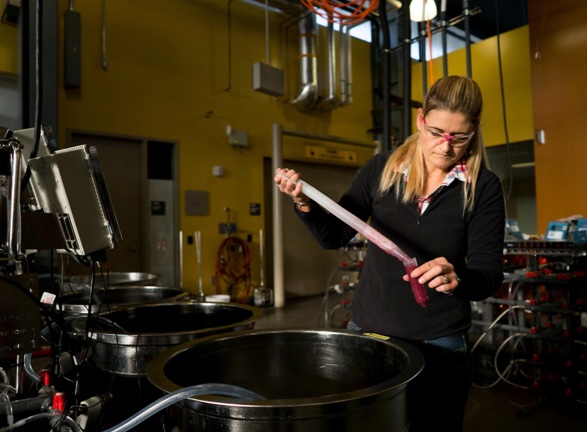
Anita Oberholster, a viticulture and enology professor of cooperative extension, samples grapes that have been tainted by smoke from wildfires.
Agriculture

Smoke-Taint Research During California Wildfires
Department: Viticulture and Enology
Importance
California wildfires have been especially hard on the state’s wine industry, damaging billions of dollars in property and grapes; wildfires of 2020 alone cost the wine industry $3.7 billion in lost property, wine inventory, grapes and wine production. When grapes are exposed to smoke, they can sometimes impart unwanted flavors into finished wine and thus must be assayed to determine if they can be used.
Impact
With existing testing labs stretched beyond capacity, CA&ES partnered with CDFA to provide hundreds of growers and vintners with a rapid assay to test wine grapes for smoke taint and outreach support on how to quickly ferment grapes in small batches during COVID-19 lockdown to test for smoke exposure.

Jiahan Zou, a Ph.D. graduate student in the Department of Food Science and Technology, holding a new form of ice cube that doesn't melt, is reusable, plastic-free and compostable.
Environment

Innovative Cooling Cubes
Department: Food Science and Technology
Importance
Ice is used to keep foods fresh but can lead to cross-contamination as it melts, potentially passing microbes to other foods or down the drain.
Impact
CA&ES researchers have developed a jelly ice cube that doesn’t melt, is reusable and antimicrobial. The jelly ice cubes offer an alternative to traditional ice and could potentially reduce water consumption, environmental impact and help manage food waste by controlling microbial contaminations.
